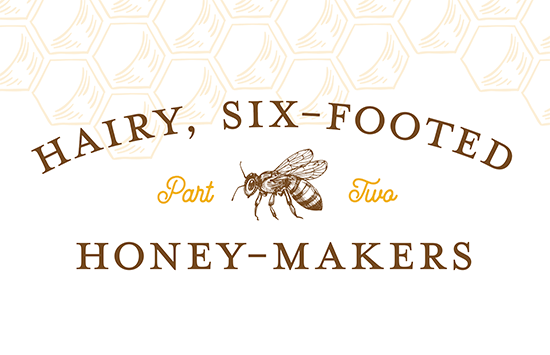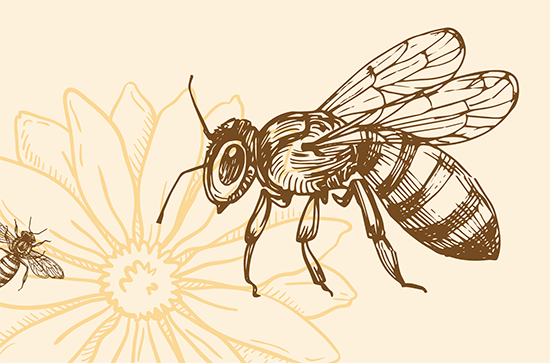
February-March 2021
Ripple Effects
------------------
|





Hairy, Six-Footed Honey Makers, Part 2
By Bill and Brenda Evans
Honey harvest—as we called it—came in high summer in northeast Kentucky. It was near noon, July-hot, and oppressively humid outside Chuck Hennecke’s honey house. But bees were working, and so was Chuck in his white beekeeper’s coverall, wide-brimmed hat and veil, and heavy latex gloves up past his wrists. All his gear was white. Bees instinctively perceive dark colors as threats, apiarists say.
Chuck and his friend Warren Rogers call honey harvest honey extraction. That’s why we were there: to watch them extract a year’s worth of honey Chuck’s bee colonies had stored in thousands of the tiny hexagonal cells of their honeycombs.
We drove our car into the grass alongside the hives to watch, double-checking that our windows were rolled up tight. Chuck lifted the top “super” off the first wooden hive among small swarms of honeybees. A super is a box in which rectangular frames are hung for bees to build honeycombs and store their honey. Chuck’s super held ten honey-heavy frames and weighed 60 pounds. Even by itself, honey is heavy. A gallon of honey weighs 12 pounds, while a gallon of water weighs just 8.3 pounds.
Minutes later, inside, extraction begins. Chuck’s honey house is a 12 by 34 foot concrete block building, white inside and out, with good lighting, two deep utility sinks, long work counters, large plastic pans to catch honey during uncapping, jars of already extracted honey stored in cardboard boxes, two large cylindrical stainless steel containers (that turn out to be a honey extractor and heater), and a blue, 55-gallon tank of bee-food syrup. His honey house is cooled and heated by an HVAC system, and out through a door into his attached woodworking shop are a shower, sink, and stool. Little is missing here except a kitchen and bedroom.
Sonya, Chuck’s wife, waits inside the honey house with fluffy homemade biscuits, butter, a jar of light amber honey, and bottles of cold water. We eat, sip water, and chit-chat.
Right away, Chuck and Warren start uncapping the hexagonal honeycomb cells, alternating between two implements: a long, straight knife and a scratcher. The knife slices or scrapes the beeswax caps off honeycomb cells. A scratcher perforates the sealed honeycomb caps. Both implements free sealed-up honey from its comb and release it into a large catch pan. It’s sticky work.

The two men banter back and forth. Warren reminds us he hates the extracting process. He’d rather be capturing feral swarms of honey bees, which many beekeepers do to sell, replenish their hives, or start new ones. Ruthie, Warren’s wife, joins him for these capturings and sometimes films the process. We’ve watched one of her videos on Warren’s phone. This season, Chuck has captured nine feral swarms.
We eat Sonya’s buttery biscuits and honey and watch the slicing and scratching. Golden honey oozes and eases out of the tiny beeswax cells into the catch pans.
“Try it,” Chuck urges. We dip a finger into the shining ooze.
“Delicious. Right out of the hive!” What more can we say, except to quote Winnie-the-Pooh: “The only reason for being a bee that I know of is making honey…And the only reason for making honey is so I can eat it.”
Pooh knew honey right out of the hive (not to mention Sonya’s tender biscuits) is a pleasure.
We’ve seen several definitions of honey. One is “a sweet viscous material elaborated out of the nectar of flowers in the honey sac of various bees.” The words material and elaborated just fail for us. That lexicographer may as well have said, “honey is stuff from nectar that is developed in a bee’s belly” and stopped there. No hint of the amazing transformation in the bee’s stomach, the regurgitation, the fanning, or the storage in cells they have also made.
On the other hand, his word viscous is good. Chuck’s and Warren’s honeys are thick and sticky, between a solid and a liquid. They ooze and ease; they don’t gush or splatter. Dip your finger in their honey—no drip or drool. It stands up a little. A fat globule. Gold! You have to lick it off, and it’s good.
Unofficially, honey is bee vomit. Officially, “Honey is the substance made when the nectar and sweet deposits from plants are gathered, modified and stored in the honeycomb by honey bees,” according to the National Honey Board. In simple language, nectar is gathered, swallowed by a forager (always female), processed in her crop (or “honey stomach,” the first of two stomachs),
regurgitated, stored in hexagonal cells, fanned with her wings at 200 times per second to remove excess moisture, capped (or sealed) with beeswax from eight glands under her abdomen, and the final result is honey.
But honey is not the only bee product. Chuck “grafts” and raises queens to sell or restock his hives. We watched him transfer 30 slimy gray, grape-seed sized larvae from worker cells to artificial cells with a tiny curved instrument. This began his latest queen-rearing process. About 16 days later, Chuck had 20 new queens. Not all survived. Another product, beeswax cappings, are reprocessed for candles, cosmetics, sealants, lubricants, chewing gum, lip balm, and more. And there’s propolis (bee glue), royal jelly, and pollen. When petroleum was scarce in World War II, beekeeping was designated “war essential.” Beeswax waterproofed munitions and other equipment, and honey replaced tightly rationed sugar.
After uncapping several frames of honeycomb, Chuck loaded his stainless steel extractor with six frames of honeycombs. Operating by centrifugal force, the extractor spins, flinging out whatever honey didn’t ooze out during uncapping. Honey pools in the bottom of the cylindrical extractor and is drained out through a spigot. The honeycomb itself is left intact and returned to the hive to be reused by the bees.
For long-term storage, honey’s water content needs to be no more than 18%. The honey heater extracts moisture to prevent fermentation and crystallization.
What does it take to be a good beekeeper? A lot, it seems to us. “Chuck likes all of it,” Warren said. “I only like parts of it.” Both men agree beekeepers must be patient and organized. Have more in mind than making honey. Be attentive and observant, willing to study and learn. If you join a beekeeper’s organization, be ready to spend some money. Warren recalls buying a queen once, and despite Ruthie’s pleasure in his hobby, she exclaimed: “You spent $45 for a bug!”
“Honey bees are amazing little creatures,” Chuck said.
Who can argue with that? One female worker/forager will fly up to five or six miles, if she needs to, to gather nectar and pollen, and she may make 15 flights a day, touching as many as 1,500 flowers. A whole colony of foragers of 30 to 60 thousand can collect four or five pounds of nectar a day, which, when processed in their honey stomachs, will produce one pound of honey. For that one pound of honey, the horde of foragers may visit two million flowers and fly 55,000 miles. A female worker/forager lives a short life—three to six weeks—and is always busy. Geoffrey Chaucer noticed this busyness back in the late 1300s and coined the phrase “busy as bees” in The Canterbury Tales.
“When you study them, you know there has to be a designer, a creator, because of what they know and do and produce,” Warren said. Do honey bees think? Warren nods. “I’ve seen workers cut off the wings of drones. They know they need the best workers and the best queen. So, they get it done.”
Our time at the honey house talking with Chuck and Warren about their “amazing little creatures,” inspired wonderment. What we learned was like what Joseph Parker, a nineteenth century British preacher, once called “white truth.” Or as he said, “lamps by which we see God…signs of a power as beneficent as it is unlimited...light upon light.”
Hairy, six-footed honey bees are white truth to us, light upon light through which we see God, His power, His unlimited beneficence to us amazing, less hairy, two-footed creatures.
About the Writer: Bill and Brenda Evans live and eat good
honey in Ashland, Kentucky. Contact them at beejayevans@windstream.net.
|
|

